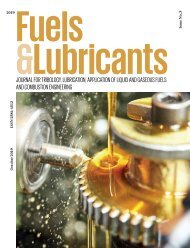Fuels & Lubricants Magazine
Issue No. 3, October 2018
Issue No. 3, October 2018
Create successful ePaper yourself
Turn your PDF publications into a flip-book with our unique Google optimized e-Paper software.
5. Polyglycole oils, ester oils and<br />
PAO show less viscosity increase<br />
with pressure than paraffinic and<br />
naphtenic mineral oil. Silicone oil<br />
is the worst.<br />
Considering all details to choose the<br />
best oil, which is able to work up to<br />
700 Mpa (7000 bars) at normal and<br />
elevating temperatures, it is possible<br />
to recommend any aircraft hydraulic<br />
oil, based on narrow cut of isoparaffines<br />
and polymer viscosity index<br />
improver, like AMG 10. Other oils<br />
formulated on PAO dimer could suit<br />
as well.<br />
The knowledge of solidification<br />
point gained experimentally in this<br />
equipment can be valuable for studies<br />
of EP and antiseize properties of<br />
oils.<br />
Literature<br />
[1] Lokajíček, T., and Svitek, T.<br />
(2015), Laboratory measurement<br />
of elastic anisotropy on spherical<br />
rock samples by longitudinal and<br />
transverse sounding under confining<br />
pressure, Ultrasonics, 56,<br />
294-302.<br />
[2] Štěpina, V. and Veselý, V.: <strong>Lubricants</strong><br />
and Special Fluids, Vol. 23,<br />
Elsevier 1992. ISBN 0-444-98674-<br />
X<br />
[3] Spikes, H.: Basics of EHL for<br />
practical application, Lubrication<br />
Science, Vol. 27, Issue 1,p. 45-67.<br />
Jan. 2015<br />
[4] Gold, P.W., Schmidt, A., Dicke,<br />
H., Loos, J., Assman, C.,: Viscosity<br />
-Pressure-Temperature Behaviour<br />
of Mineral and Synthetic Oils. J.<br />
Synthetic Lubrication 18-1, p. 51-<br />
79, April 2001.<br />
<strong>Fuels</strong>&<strong>Lubricants</strong> No. 3 OCTOBER 2018 9







